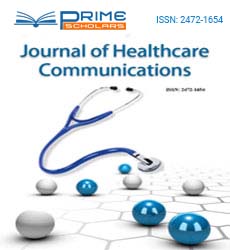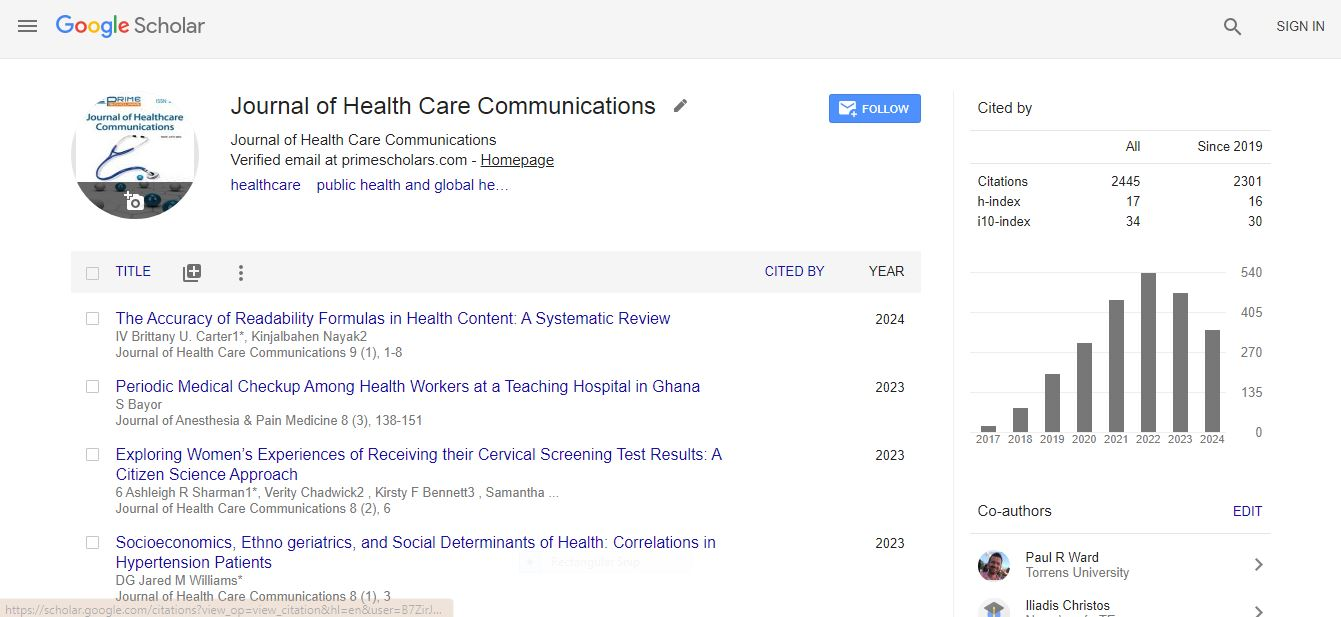Opinion Article - (2025) Volume 10, Issue 2
Healthcare Online Services: Shaping Communication Between Providers and Patient
Adam Wing*
Department of Medicine, University of Toronto, Toronto, Canada
*Correspondence:
Adam Wing, Department of Medicine, University of Toronto, Toronto,
Canada,
Email:
Received: 03-Jun-2025, Manuscript No. IPJHCC-25-22775;
Editor assigned: 05-Jun-2025, Pre QC No. IPJHCC-25-22775 (PQ);
Reviewed: 19-Jun-2025, QC No. IPJHCC-25-22775;
Revised: 26-Jun-2025, Manuscript No. IPJHCC-25-22775 (R);
Published:
03-Jul-2025, DOI: 10.36846/2472-1654.25.10.68
Description
Healthcare policies provide the framework within which medical services are designed, delivered and regulated. They encompass laws, guidelines and administrative actions that shape how healthcare systems operate. Effective policy communication is essential, as it ensures that governments, institutions, healthcare workers and the public understand both the intent and the impact of these regulations. Without clear communication, policies risk being misinterpreted, inconsistently applied, or met with resistance.
Healthcare policies often begin with a recognition of public health needs. For example, the rise in chronic diseases such as diabetes and hypertension has led to the creation of national programs promoting preventive care and lifestyle interventions. Communicating these policies involves translating technical language into accessible information that resonates with the public. Campaigns using print media, television and digital platforms help individuals understand their role in prevention and how services are available to support them.
Communication is also central to policymaking itself. Policymakers depend on dialogue with researchers, medical professionals and community representatives to design effective rules. Public consultations, expert panels and stakeholder meetings create spaces for discussion where feedback can be integrated into final decisions. This process not only strengthens policy design but also enhances acceptance, as stakeholders feel their concerns have been considered.
Regulatory policies, particularly those concerning medical licensing, drug approval and patient safety, require transparent communication to avoid confusion. For example, when a new vaccine is approved, healthcare providers must receive detailed guidance on dosage, eligibility and storage. Simultaneously, the public needs simple messages clarifying safety and accessibility. Miscommunication in this process can lead to misinformation, mistrust, or even vaccine hesitancy.
Healthcare financing policies also illustrate the importance of communication. Insurance schemes, subsidies and reimbursement frameworks must be communicated effectively to ensure that beneficiaries understand their rights and responsibilities. Complex insurance documents can discourage participation, especially among individuals with limited health literacy. Simplified brochures, multilingual support and online helpdesks improve comprehension and increase participation in health programs.
The COVID-19 pandemic demonstrated both the strengths and weaknesses of policy communication. Governments worldwide issued policies on lockdowns, mask mandates, testing and vaccination. In some cases, clear and consistent communication built trust and compliance. In others, conflicting messages created confusion and resistance. The experience highlighted the need for governments to communicate policies in ways that are timely, evidence-based and culturally sensitive.
Healthcare policies must also consider ethical communication. Policies on end-of-life care, reproductive health, or mental health often spark debates influenced by cultural and religious beliefs. Policymakers need to communicate sensitively, balancing evidence-based recommendations with respect for diverse values. Open forums, patient advocacy groups and targeted education campaigns help create understanding while minimizing conflict.
International health policies, coordinated by organizations such as the World Health Organization (WHO), rely heavily on communication. Global strategies on issues such as antimicrobial resistance, climate-related health risks, or pandemic preparedness require collaboration among nations. Standardized guidelines and multilingual communication ensure that countries with different capacities can align their responses. Shared databases, global surveillance systems and joint training programs further enhance cross-border cooperation.
At the institutional level, hospitals and healthcare organizations must communicate policies internally to ensure compliance. Policies on infection control, staff safety, or digital record management must be clearly conveyed to all employees. Training workshops, digital handbooks and compliance audits help reinforce these guidelines. Poor communication of policies at the organizational level can lead to preventable errors, legal liabilities and compromised patient care.
Another dimension is the role of healthcare policy in advancing equity. Policies addressing marginalized groups such as rural populations, low-income households, or individuals with disabilities require tailored communication strategies. For example, telemedicine policies intended to expand rural access must be communicated through local networks, community leaders and radio broadcasts to reach populations with limited internet access. Ensuring inclusivity in communication strengthens policy impact and reduces inequalities.
Technological advancement has added new opportunities and challenges to policy communication. Digital health policies concerning electronic records, teleconsultations and artificial intelligence tools must be explained to both professionals and the public. Professionals need training on how to use these systems securely, while patients must understand how their data is stored and protected. Concerns about privacy, security and consent highlight the need for transparent communication in this rapidly evolving field.
Feedback is essential in healthcare policy communication. Policies that are rigid and unresponsive to community needs often fail. Mechanisms such as surveys, grievance redressal systems and patient advisory boards provide channels for feedback. This two-way communication ensures that policies evolve to reflect real-world challenges. For example, feedback from frontline healthcare workers during the pandemic led to revised guidelines on protective equipment and work shifts.
Finally, trust is the foundation of effective policy communication. When the public trusts that policies are based on evidence and implemented fairly, compliance improves. Transparency about decision-making, clear explanation of trade-offs and open access to information help build and maintain this trust. Conversely, lack of transparency can lead to skepticism and non-adherence, undermining even the most well-designed policies.
Conclusion
Healthcare policies guide the structure and delivery of medical services, but their effectiveness depends on how well they are communicated. Policymakers must engage stakeholders during design, convey clear and accessible messages during implementation and remain responsive to feedback during evaluation. At the global, national and institutional levels, transparent communication builds trust and compliance, while neglecting communication creates confusion and resistance. In an era of rapid medical innovation and global health challenges, effective communication of healthcare policies is not merely an administrative requirement it is an essential component of public health success.
Citation: Chen L (2025) Healthcare Online Services: Shaping Communication Between Providers and Patient. J Health Commun. 10:68.
Copyright: © 2025 Chen L. This is an open-access article distributed under the terms of the Creative Commons Attribution License, which permits unrestricted use, distribution, and reproduction in any medium, provided the original author and source are credited.

